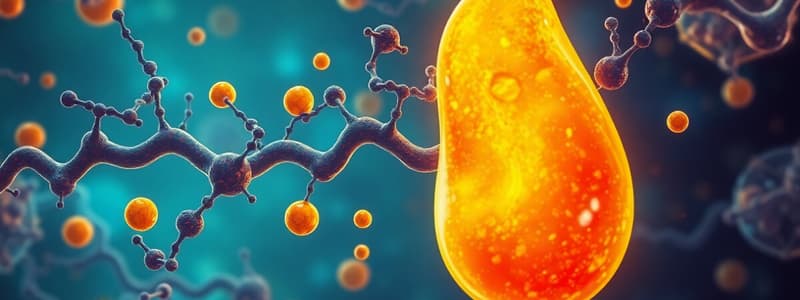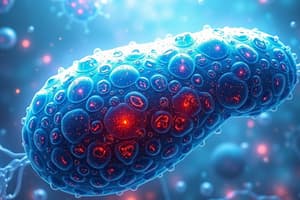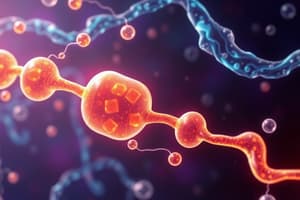Podcast
Questions and Answers
Which of the following is NOT a class of lipids?
Which of the following is NOT a class of lipids?
- Fatty Acids (correct)
- Sterols
- Phospholipids
- Triacylglycerols
Polyunsaturated fatty acids pack more tightly than saturated fatty acids due to increased interactions between their alkyl chains.
Polyunsaturated fatty acids pack more tightly than saturated fatty acids due to increased interactions between their alkyl chains.
False (B)
In the systematic symbolic representation for a fatty acid denoted as '18:4 Δ6,9,12,15,' what do the numbers '6, 9, 12, 15' indicate?
In the systematic symbolic representation for a fatty acid denoted as '18:4 Δ6,9,12,15,' what do the numbers '6, 9, 12, 15' indicate?
the positions of the double bonds
Fatty acids are stored in adipose tissue as ____________ .
Fatty acids are stored in adipose tissue as ____________ .
Match each enzyme to its function in fatty acid degradation:
Match each enzyme to its function in fatty acid degradation:
What is the primary location of fatty acid degradation?
What is the primary location of fatty acid degradation?
The activation of a fatty acid for degradation requires the expenditure of two ATP molecules.
The activation of a fatty acid for degradation requires the expenditure of two ATP molecules.
What molecule is required to transport acyl CoA across the inner mitochondrial membrane?
What molecule is required to transport acyl CoA across the inner mitochondrial membrane?
During β-oxidation, acyl CoA dehydrogenase creates a __________ double bond between the α and β carbons.
During β-oxidation, acyl CoA dehydrogenase creates a __________ double bond between the α and β carbons.
Match the enzyme involved in β-oxidation with the reaction it catalyzes:
Match the enzyme involved in β-oxidation with the reaction it catalyzes:
Which enzyme is required to degrade cis-Δ3-enoyl CoA during fatty acid degradation?
Which enzyme is required to degrade cis-Δ3-enoyl CoA during fatty acid degradation?
The degradation of cis-Δ4-enoyl CoA requires only one additional step compared to the standard β-oxidation pathway.
The degradation of cis-Δ4-enoyl CoA requires only one additional step compared to the standard β-oxidation pathway.
What product is formed when propionyl CoA is carboxylated during the degradation of odd-chain fatty acids?
What product is formed when propionyl CoA is carboxylated during the degradation of odd-chain fatty acids?
Ketone bodies are synthesized from __________ in the liver during fatty acid degradation.
Ketone bodies are synthesized from __________ in the liver during fatty acid degradation.
Match the ketone body with its formation process:
Match the ketone body with its formation process:
Which of the following hormones stimulates the activation of lipases in adipocytes, leading to the release of fatty acids?
Which of the following hormones stimulates the activation of lipases in adipocytes, leading to the release of fatty acids?
3-hydroxybutyrate is transported to other tissues where it is converted directly into acetyl CoA.
3-hydroxybutyrate is transported to other tissues where it is converted directly into acetyl CoA.
What enzyme converts acetoacetate to acetoacetate CoA?
What enzyme converts acetoacetate to acetoacetate CoA?
The regulation of fatty acid degradation relies mainly on the control of free fatty acids __________ from adipose tissue.
The regulation of fatty acid degradation relies mainly on the control of free fatty acids __________ from adipose tissue.
Associate each step with the corresponding process in fatty acid degradation:
Associate each step with the corresponding process in fatty acid degradation:
Flashcards
What are Lipids?
What are Lipids?
Organic compounds, including fats, oils, waxes and steroids. They aren't just fatty acids.
What is a Fatty Acid (FA)?
What is a Fatty Acid (FA)?
A fatty acid with a carboxyl group at one end and a linear alkyl chain.
What does FA 18:4 △6,9,12,15 mean?
What does FA 18:4 △6,9,12,15 mean?
Notation indicating 18 carbons and four double bonds at carbons 6-7, 9-10, 12-13, 15-16.
What are Polyunsaturated FAs?
What are Polyunsaturated FAs?
Signup and view all the flashcards
What is FA Degradation?
What is FA Degradation?
Signup and view all the flashcards
Describe FA activation.
Describe FA activation.
Signup and view all the flashcards
How is Acyl CoA transported into mitochondria?
How is Acyl CoA transported into mitochondria?
Signup and view all the flashcards
What is β-Oxidation?
What is β-Oxidation?
Signup and view all the flashcards
What happens in the first step of β-Oxidation?
What happens in the first step of β-Oxidation?
Signup and view all the flashcards
What happens in the second step of β-Oxidation?
What happens in the second step of β-Oxidation?
Signup and view all the flashcards
What happens in the third step of β-Oxidation?
What happens in the third step of β-Oxidation?
Signup and view all the flashcards
What happens in the fourth step of β-Oxidation?
What happens in the fourth step of β-Oxidation?
Signup and view all the flashcards
How is cis-∆3-enoyl CoA degraded?
How is cis-∆3-enoyl CoA degraded?
Signup and view all the flashcards
How is cis-△4-enoyl CoA degraded?
How is cis-△4-enoyl CoA degraded?
Signup and view all the flashcards
Degradation of FAs containing cis- ∆3,6-dienoyl CoA
Degradation of FAs containing cis- ∆3,6-dienoyl CoA
Signup and view all the flashcards
How is odd-chain FA degraded?
How is odd-chain FA degraded?
Signup and view all the flashcards
How is FA degradation regulated?
How is FA degradation regulated?
Signup and view all the flashcards
Study Notes
- Lipids encompass more than just fatty acids (FA) and are categorized into five classes.
- Fatty acids (FA) consist of a carboxyl group at one end and a linear alkyl chain, which may include one or more cis double bonds.
- The systematic symbolic representation for FA indicates the number of carbons and the position of double bonds (e.g., 18:4 Δ6,9,12,15 signifies 18 carbons and four double bonds at positions 6-7, 9-10, 12-13, and 15-16).
- Polyunsaturated FA have weaker interactions due to less tight packing, resulting in lower melting points compared to saturated FA.
- Fatty acids are stored as triacylglycerol (TAG) in adipose tissue.
FA Degradation
- FA degradation occurs in the mitochondrial matrix, requiring initial activation and transport.
- FA is adenylated by expending ATP, creating fatty acyl-AMP; AMP is then replaced by CoA, forming acyl CoA, a reaction catalyzed by acyl CoA synthetase.
- Acyl CoA is converted to acyl carnitine via carnitine acyltransferase I, replacing CoA with carnitine.
- Acyl carnitine is transported across the inner mitochondrial membrane by an antiporter, which simultaneously transports carnitine out of the matrix.
- In the matrix, acyl carnitine is converted back to acyl CoA by carnitine acyltransferase II.
β-Oxidation
- β-Oxidation is the main pathway for degrading FA into acetyl CoA.
- Acyl CoA dehydrogenase introduces a trans double bond between carbons 2 and 3 (α-β, Δ2), reducing FAD to FADH2 with the released electrons.
- Enoyl CoA hydratase adds a water molecule to the trans double bond, forming L-3-hydroxyacyl CoA.
- L-3-hydroxyacyl CoA dehydrogenase oxidizes the hydroxyl group on carbon 3 (β) into a ketone, producing NADH from NAD+ with the liberated electrons.
- Thiolase cleaves 3-ketoacyl CoA to produce acetyl CoA and a shortened acyl CoA (by two carbons).
- The cycle repeats until the acyl chain is completely converted to acetyl CoA.
Degradation of cis-Δ3-enoyl CoA
- cis-Δ3-enoyl CoA isomerase replaces the first step of β-oxidation (acyl CoA dehydrogenase), converting cis-Δ3-enoyl CoA to trans-Δ2-enoyl CoA.
- β-oxidation follows the conversion.
Degradation of cis-Δ4-enoyl CoA
- After the first step of β-oxidation (acyl CoA dehydrogenase), produces a 2,4-dienoyl CoA intermediate, the following two steps are inserted:
- 2,4-dienoyl CoA reductase uses NADPH to reduce the 2,4-dienoyl CoA intermediate to trans-Δ3-enoyl CoA.
- cis-Δ3-enoyl CoA isomerase converts trans-Δ3-enoyl CoA to trans-Δ2-enoyl CoA.
- β-oxidation follows.
Degradation of FAs containing cis-Δ3,6-dienoyl CoA
- cis-Δ3-enoyl CoA isomerase converts the cis-Δ3 bond to trans-Δ2.
- One round of β-oxidation removes the first two carbons, yielding cis-Δ4-enoyl CoA.
- Further degradation proceeds similarly to the cis-Δ4-enoyl CoA degradation pathway.
Degradation of FAs containing cis-Δ4,7-dienoyl CoA
- cis-Δ4 is converted to trans-Δ2.
- Two rounds of β-oxidation are performed.
- The resulting product, cis-Δ3-enoyl CoA, is processed.
Degradation of odd-chain fatty acid (Propionyl CoA)
- Propionyl CoA carboxylase carboxylates propionyl CoA to produce methylmalonyl CoA, a four-carbon fragment.
- Methylmalonyl CoA is converted to succinyl CoA, which is then incorporated into the TCA cycle.
Ketone Bodies
- Ketone bodies are synthesized in the liver from acetyl CoA derived from FA degradation.
- Acetyl CoAs combine to form acetoacetate initially.
- Acetoacetate is reduced by NADH to produce 3-hydroxybutyrate or spontaneously decarboxylated to form acetone.
- 3-hydroxybutyrate is transported to other tissues and converted back to acetyl CoA.
- 3-hydroxybutyrate is oxidized back to acetoacetate, which is then attached to CoA by CoA transferase.
- Thiolase converts acetoacetate CoA to acetyl CoA.
Regulation of Fatty Acid Degradation
- The release of free fatty acids from adipose tissue primarily regulates fatty acid degradation.
- Glucagon and epinephrine activate PKA in adipocytes.
- PKA activation leads to the activation of lipases, which release fatty acids from triacylglycerol (TAG).
- Fatty acids are then transported to other cells for metabolism.
Studying That Suits You
Use AI to generate personalized quizzes and flashcards to suit your learning preferences.




